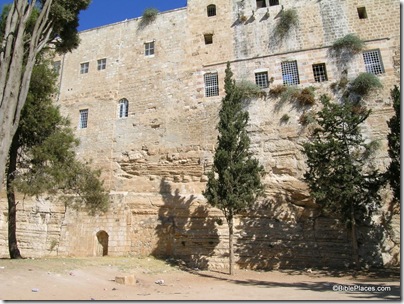The Departments of Archaeology and Biblical Studies at the University of Haifa would like to invite you to attend a conference on the subject:
“Egypt, Canaan and Israel: History, Imperialism and Ideology from the third to the first millennium BCE,” to be held at the University of Haifa, May 3-7, 2009.
The conference aims at discussing the political, military, cultural, economic, literary and administrative relations between Egypt, Canaan and Israel along the Millennia in the ideological level and in everyday life, according to literary and non-literary texts, plastic art, and archaeology.
Lectures:
Mrs. Ben Dor S.
Tel Aviv University, Israel
Shishak’s Karnak Relief, in Comparison to Triumphal Reliefs of the NK in Karnak and
Medinet Habu
Dr. Ben Tor D.
Israel Museum, Jerusalem, Israel
Egyptian-Canaanite Relations in the Middle and Late Bronze Ages as Reflected by Scarabs
Dr. Binder S.
Macquarie University, Sydney, Australia
The Egyptian Background to the Investiture of Joseph
Prof. Dr. Fischer-Elfert H. W.
University of Leipzig, Germany
A Fresh look at Palestine and Syria in Pap. Anastasi I: Toponyms, Archaeology and Literature
Dr. Gee J.
Brigham Young University, USA
The Export of the Egyptian Scribe
Dr. Gnirs A. M.
University of Basel, Switzerland
Narrativity in History: The Egyptian Brave Hero
Prof. Hasel M. G.
Southern Adventist University, USA
To be announced
Prof. Hoffmeier J.
Trinity International University, USA
Did Seti I Reestablish Egyptian Hegemony in Canaan?
Dr. Kahn D.
University of Haifa, Israel
One Step Forward, Two Steps Back: Egypt and Mitanni during the Amarna Age
Mr. Kraim Z.
Tel Aviv University, Israel
Logistical units and supply in the Egyptian army in New Kingdom
Dr. Ladynin I.
Lomonosov Moscow State University, Russia
‘Neos Sesonchosis Kosmokrator’: The Theme of Lost and Restored World Domination and the
Egyptian Propaganda Before and Under Alexander the Great
Dr. Lehmann G.
Ben-Gurion University, Beer Sheva, Israel
An Egyptian Interlude: Egyptian Imperialism in the Levant between the Assyrian and the Neo-
Babylonian Empire according to the Archaeological Evidence
Prof. Mazar A.
Hebrew University, Jerusalem, Israel
The Egyptian Garrison Town at Beth Shean in Light of the New Excavations (1989-1996)
Dr. Mizrachi Y.
University of Haifa, Israel
Hatschepsut – Founder of an Egyptian Emporium?
Dr. Morenz L.
University of Leipzig, Germany
Cultural Misunderstandings due to the Differences in the Egyptian versus the Canaanite
Cultural Code
Dr. Muhlestein K.
Brigham Young University, USA
The Footprint of Levantine Influence in the Shipwrecked Sailor
Dr. Müller M.
Roemer-und Pelizaeus-Museum, Hildesheim, Germany
A View to a Kill: Egypt’s Grand Strategy in her Northern Empire
Prof. Noegel S.
University of Washington, USA
The Ark of the Covenant and Egyptian Solar Boats: A Comparative Study
Prof. Ockinga B.
Macquarie University, Sydney, Australia
The Names of Emmanuel in Isaiah 9:5
Prof. Oren E.
Ben-Gurion University, Beer Sheva, Israel
Egyptian administration on the Ways of Horus and Canaan during the reign of Seti II
Dr. Von Recklinghausen D.
University of Tübingen, Germany
To be announced
Prof. Dr. Schipper B. U.
University of Bremen, Germany
Egypt and the Kingdom of Judah in the 26th dynasty
Prof. Dr. Schneider T.
University of British Columbia, Vancouver, Canada
“The Assyrian conquest in disguise: rewriting Egyptian history in the “Struggle for the
Benefice of Amun”
Dr. Shirley JJ
The Johns Hopkins University, Baltimore, USA
What’s in a Name? Military and Civil Officials in the 18th Dynasty Military Sphere
Prof. Shupak N.
University of Haifa, Israel
To be announced
Dr. Sweeney D.
Tel Aviv University, Israel
A Long Way from Home: Women from the Levant in Ancient Egypt
Prof. Tower Hollis S.
Empire State College, USA
Two Hymns as Praise Poems, Royal Ideology, and History in Ancient Israel and Ancient Egypt: A Comparative Reflection
Dr. Vogel C.
University of Mainz, Germany
This Far and Not a Step Further! The Ideological Concept of Ancient Egyptian Boundary
Stelae
Prof. Warburton D. A.
Université Lumière Lyon, France
Dr. Raedler C.
University of Mainz, Germany
The End of the Egyptian Presence in the Bronze Age
Prof. Zertal A.
University of Haifa, Israel
El-Ahwat, a New Discovery on the Shardana and Egypt in the 12th century
The Sandal-shaped Enclosures in the Jordan Valley and their Egyptian and Biblical
Connections
Tours:
Tuesday, May 5, 0700: “In the Footsteps of Thutmosis III”: Excursion to Wadi ‘Arah and Megiddo.
Wednesday, May 6, 1730: Visit to the Hecht Archaeological Museum in Haifa.
Optional Tour: Thursday, May 7, 0700: Departure to Jordan Valley excursion.
Conference price for non-lecturers: $250 per person for the entire conference (places must be booked
in advance with the organizing Committee, pending availability).
Additional information can be found at the conference website.
HT: Joe Lauer


